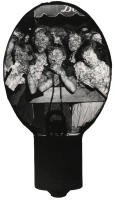Associated Press, Atomic Bomb Sends Smoke 20,000 Feet Above Nagasaki, August 9, 1945
This photo, taken by the air force just moments after the atomic bomb Fat Boy was dropped on the city of Nagasaki, embodies the enduring image many Americans think of when hearing the words “atomic bomb.” When viewed together with the atomic test images from New Mexico and Bikini Atoll this image is nearly indistinguishable. Its scale renders invisible the 70,000 to 90,000 Japanese civilians who died as a result of the explosion.
Shortly after the Japanese surrendered, the United States made the suppression of images from Hiroshima and Nagasaki a major imperative; both in Japan and in the United States. The Civil Censorship Detachment, an American office of SCAP, developed 31 topics that were comprehensively banned from all forms of media. The longest standing of these topics was the suppression of atomic bomb documentation from both sites.
[Ruins of Nagorekawa Church, Hiroshima], October 14–November 26, 1945
Even this image from Hiroshima, taken as part of the United States Strategic Bomb Survey conducted from October 14–November 26, 1945, was intended only as assessment tool to gauge the effectiveness of American campaigns during the war. And, as catagoric as this assessment was, the resulting survey failed to convey the human cost of atomic warfare.
However, one Japanese photographer, Yosuke Yamahata, took over 100 exposures of his countrymen in a twelve-hour period as they struggled to cope with the realities of the bombing at Nagasaki. These images would later become the most extensive documentation of the destruction of the atomic bomb blasts in either city. They were finally released to the American public in Life on September 29, 1952.
Yosuke Yamahata, Injured Mother Suckling Baby as They Both Await Doctor Following Atomic Bomb Test, 1945
In a 1965 television broadcast, a tearful J. Robert Oppenheimer recounted his thoughts following the first atomic test at Trinity in Alamagordo, New Mexico:
“We knew the world would not be the same. A few people laughed, a few people cried. I remember the line from the Hindu scripture, the Bhagavad-Gita, Vishnu is trying to persuade the prince that he should do his duty, and to impress him takes on his multi-arm form and says ‘now I am become death, the destroyer of worlds.’”
Alfred Eisenstaedt, J. Robert Oppenheimer, director of the Institute for Advanced Study, Princeton, New Jersey, 1947





